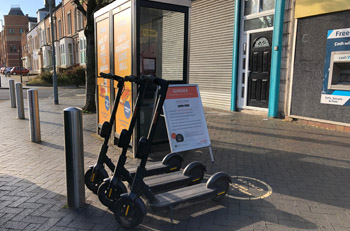As the Transport Select Committee gives qualified backing to the legalisation of electric scooters, Chris Ames looks at the issues considered by its inquiry and the role e-scooters could play in the transport networks of the future.
Following publication of the committee’s report, its chair, Huw Merriman MP, said: ‘e-scooters have the potential to become an exciting and ingenious way to navigate our streets and get from place to place. If this gets people out of the car, reducing congestion and exercising in the open air, then even better.’

Future of transport minister Rachel Maclean had already made clear that it was by no means certain e-scooters are the future. She told MPs: ‘I want to stress to the committee that it is not a done deal; we need to consider carefully whether legalising e-scooters is right for this country.’
The controversial devices remain literally on trial after the Government announced in June that it was fast-tracking trials of rental e-scooters only – and not on the footway.
Trials are taking place across the country, including in the Tees Valley Combined Authority, the West Midlands, Norwich, and, of course, Milton Keynes.
These test runs have been brought forward – and will be taking place in more areas than initially planned – after the Department for Transport (DfT) launched a consultation in May on urgent legislation to allow this.
If there is a sense that Britain is playing catch-up, spurred on by the pandemic, that is probably because it is true. It remains illegal to use a privately owned e-scooter on the road or the footway. Other European cities such as Copenhagen, and particularly Paris, where e-scooters have been legal for a while, have thousands or even tens of thousands.
Originally, e-scooters were part of a wider plan that was set to evolve much less rapidly. The Future of mobility: urban strategy paper was launched in March 2019 by the then ‘future of mobility’ minister, Jesse Norman.
The paper included what the DfT described as ‘the biggest review into transport in a generation’. Officials said the review would explore regulations around new types of vehicles, known as micromobility vehicles, including e-scooters and e-cargo bike trailers.
In March 2020, as the lockdown kicked in, ministers announced three new ‘future of transport zones’, in Portsmouth and Southampton, the West of England, and Derby and Nottingham, joining the existing zone in the West Midlands.
The DfT also published a call for evidence on what was now called the Future of Transport Regulatory Review, including whether certain micromobility vehicles (such as e-scooters) should be permitted on the road, the impact they may have on UK transport and whether local authorities should have extra powers to manage the impacts of e-scooters on public spaces, for example where they can be parked.
At that time, it anticipated running trials of e-scooters in the four zones next year.
Two months later the department announced that, as a result of COVID-19, it would bring the possibility of trials forward. It said this will support its ‘green restart’ of local transport and help mitigate reduced capacity on public transport.
The decision to focus on trials of rented e-scooters makes them easier to control but also suggests that the DfT sees them as the micromobility-as-a-service part of the wider Mobility as a Service (MaaS) agenda, in which the traveller is a consumer of mobility options.
Published following the consultation, the rules for the trials give other pointers as to what a framework for legalisation might look like. With almost no-one supporting the idea of e-scooters on the footway, they can be ridden on the road, (except motorways) and in cycle lanes.
The DfT also published an amended definition of an e-scooter for the purpose of the trials, which introduced a power limit of 500W, increased the maximum weight to 55kg, increased the maximum speed to 15.5mph (25km/h), and allowed variations with seats.
It said the changes took account of the characteristics of most e-scooter rental vehicles. Officials said the speed limit was chosen partly to test the limit proposed in the Regulatory Review.
They added: ‘What type of modal shift we see in trials is also important in maximising the potential benefits of e-scooters; the benefits for air quality, emissions and safety are likely to be greater where people use e-scooters instead of cars. A higher speed limit is likely to encourage more users not to make journeys by car.’
What is the point of the e-scooter?
Having seen them as a potential part of the future of mobility, the DfT has said that they ‘could be a fast and clean way to travel that eases the burden on the transport network and allows for social distancing’.
Although the Government is no longer discouraging people from using public transport, it is clear that e-scooters could fill a gap, particularly as attention returns to the longer-standing issues of climate change and toxic air pollution.
In September, council directors’ body ADEPT launched a position paper on the issue. It said it backed legalisation but that a number of questions need to be answered, including whether they should be allowed in bus and cycle lanes, ensuring safety, age limits, technical standards and insurance.
ADEPT will be collecting evidence from members on rental trials, collating case studies and working on best practice as well as developing guidance.
Mark Stevens, chair of ADEPT’s Engineering Board, said: ‘Managed safely, e-scooters can be an important part of tackling poor air quality.
They can be part of the first mile/last mile component of journeys between home, work, and transport hubs. Short journeys to local shops and schools can be on e-scooters (where age appropriate) reducing our dependence on the car and lowering emissions.’
Indeed, one of the questions in the DfT’s Future of Transport call for evidence was on what mode of transport respondents would expect micromobility vehicles to replace if legal.
In its response, the Chartered Institution of Highways and Transportation (CIHT) referred to a study in Denmark asking users of micromobility vehicles what transport modes they would have used instead.
The split was: 50% walking, 35% cycling, 25% public transport, 11% car, 3% would not have travelled, 1% taxi.
Of course, if e-scooters are replacing walking or cycling, people will have replaced an active form of travel with an inactive one. As the Parliamentary Advisory Council for Transport Safety (PACTS) baldly pointed out, e-scooters involve no physical exertion and provide no health benefit to the user.
Ms Maclean told MPs that she expected to see a mode shift away from cars but was unable to put a figure on it, adding: ‘We believe that these micromobility aids can provide a more active form of transport at this time.’
She also suggested that e-scooters may provide an option to people who would not otherwise cycle: ‘Travelling in a skirt or a dress and not being able to shower when you get to work means that cycling does not always work for people.’
Another relevant question is what micromobility vehicles might facilitate – for example people might be persuaded to take the train rather than driving because the trip to the station has just become a lot easier. In suburban settings without hire facilities, this is likely to be the passenger’s own vehicle, although in urban centres a rental e-scooter may replace a taxi or bus journey.
Safety first
The safety issues around e-scooters relate to users and to non-users, mainly pedestrians.
The ‘pavement nuisance’ part of the Transport Committee inquiry appears to concern fears that they will continue to be used illegally on footways and be abandoned on them.
The National Federation of the Blind of the UK (NFBUK) felt so strongly about the risks that it wrote to local authorities asking them not to take part in trials.
‘E-scooters quickly become trip hazards and barriers for independent accessibility as they block the pavements, pedestrian crossings and public spaces,’ it wrote.

London, with St Paul's, as it looks now
Looking at the safety of users, the Local Government Technical Advisers Group (LGTAG) said that if they are as vulnerable as cyclists, this would be the greatest cost associated with their use.
In its response to the Future of Transport consultation, the CIHT highlighted safety, and in particular ‘the poor condition of the local highway network’ among wider issues that it said need to be addressed for the implementation of micromobility vehicles to be successful.
It pointed out that micromobility modes have small wheels, ‘which are vulnerable to sudden stops’, adding that in Denmark, where micromobility modes are more widespread, the injury rate has been seven to eight times that of cycling, ‘reflecting the instability of micromobility vehicles’.
The issue of road condition was highlighted when Emily Hartridge was killed in a crash involving an electric scooter and lorry in south London in 2019. Her boyfriend, Jake Hazell, described the condition of the road as ‘shocking’ and said this ‘had a massive part to play’ in the crash.
The case provides a foretaste of the pressure that councils will find themselves under if riding an e-scooter on the highway becomes legal.
Whether or not the road surface is adequate, the main risk to e-scooter users is likely to be from other motorised vehicles. It has been suggested that limiting their use to slower roads would cut this risk but many see safety in the expansion of cycle lanes.
Alan Clarke of rental firm Lime told MPs: ‘When we are talking about safety, the biggest impact that we can have when we are considering the safety of bikes, e-bikes, walking, e-scooting or anything that is not in a car is the design of our cities.
‘That is one of the reasons why, for example, we share lots of data with cities where we operate that can help enhance decision-making about where to put a segregated cycle lane, for example.’
The suggestion that data showing which roads vulnerable users are using can help safety echoes the recent case of Devon County Council using GPS cycling and running app Strava to focus cash on improving the condition and resilience of high-usage roads.
On the issue of where e-scooters might be allowed, LGTAG says they should be allowed on the road but suggests they should only be allowed to use single carriageway roads that have street lighting, footways and a speed limit of less than 30mph.
On whether they should be allowed in bus lanes and pedestrianised areas, LGTAG argues that this should be for highways authorities to decide based on individual circumstances.
Changing the landscape
While most of the discussion has been about how e-scooters might be integrated into the existing landscape, there will also be ways in which our urban areas might need to change.
LGTAG suggests that any increase in e-scooter use would be matched by an increase in demand for e-scooter parking. While many users will take e-scooters with them, parking may be needed, especially for hired vehicles to avoid them being abandoned. It says parking should include an anchor point and ideally be covered and have charging facilities.
The CIHT also argued that another precondition to ensure uptake of micromobility vehicles, along with walking and cycling, is to make sure that these are viable transport options – ‘this means planning needs to consider transport to make sure that we build places that are well connected and accessible via these transport modes’.

London as it might look in the future
Earlier this year, motor insurance firm Admiral looked into the future of city planning with an eye on the impact of COVID-19. It argues that the pandemic has caused some cities to accelerate plans to transform their centres and re-design spaces in response to climate change.
It analysed plans published by cities across the UK and ‘re-imagined’ what cities across the world could look like in the future, then worked with a designer to re-design images of 10 of the world’s busiest city centres (see images above of London).
Clare Egan, head of motor at Admiral, says: ‘The last few months have given us all a glimpse of the future with people opting for different ways to move around; from electric vehicles and e-scooters, to more traditional methods like walking and cycling.
‘We believe decision-makers in all cities should commit to more permanent infrastructure plans for more safe and sustainable travel for road users and pedestrians, and not just temporary plans.
‘The world of transport is evolving quickly and cities need to evolve alongside it to meet demand and keep people safe.’





